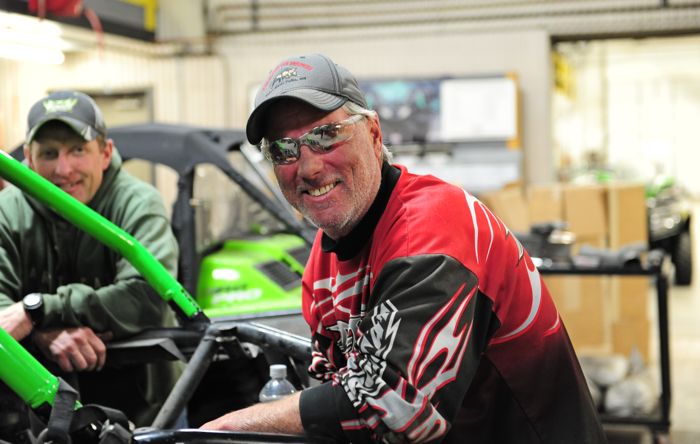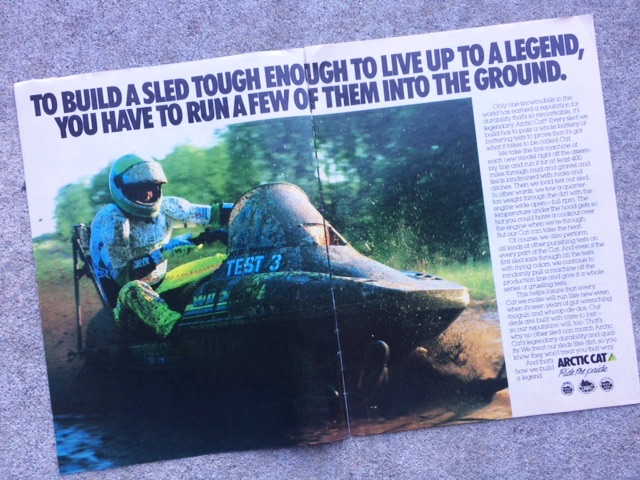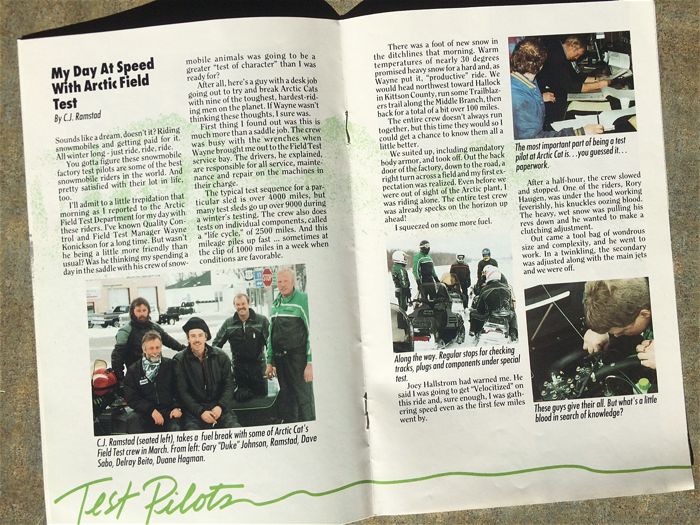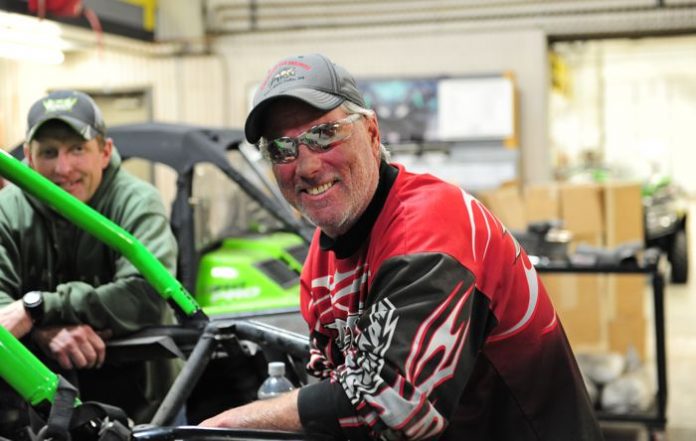
This week at Arctic Cat in Thief River Falls, Minn., Gary “Duke” Johnson logged his last miles aboard a snowmobile (or ATV) as field test rider for Arctic Cat, a job he’s had since 1979. At the tender age of 64, the Thief River Falls native is riding off into the proverbial sunset called retirement, having ridden more than 1 million miles aboard snowmobiles during his career in the company’s Field Test department.
Let that sink in for a moment. One. Million. Miles.
In simple terms, the job of a field test rider is to ride snowmobiles and/or, usually every day. So yes, Duke has had a job that most of us would dream for: getting paid to ride snowmobiles.
I chatted with Duke this week about his career with Arctic Cat. Click to read what it was like to become a million mile man.
AI: Duke, you’ve had an amazing career at Arctic Cat. When did it start?
Johnson: I first came to work here in 1970 as a welder. I did that until I got a job in Field Test in 1979, which I did until Arctic Enterprises went out of business. When Arctco started back up, I got a job welding again in 1983, and then started back in Field Test in January of 1984. I’ve been doing this ever since.
AI: I’ve always found it pretty fascinating that people get paid to ride snowmobiles. Describe in general terms what you’ve done as a Field Test rider all these years.
Johnson: Well, I test ride snowmobiles mostly, but also ATVs, usually to determine the durability of various components or the machine itself. My official title is Senior Technician, but everyone still refers to it as Field Test. I’m one of a team of riders, and most days we have a specific number of miles or hours to ride. Sometimes we have a certain duty cycle that we do with a machine, such as accelerations or “consumer riding duty,” and other times we’re just logging miles at our own pace. We pair up on these rides, with at least two people heading out together for the sake of safety.
Usually we ride prototype or pre-production machines, but sometime we ride production machines that have just come off the assembly line.
AI: Do you ride one type of machine, such as Trail Performance sleds, or do you ride a variety?
Johnson: We ride all the various models. I could be on a 6000 one day, a Pantera the next, a Crosstour the following day and a Bearcat after that. Sometimes we stick with one machine for a complete test span, it just depends on the situation and what the Engineering department needs from us.
Usually we’re on prototype sleds, but we also run production sleds too. The production sleds we’ll run for a few hundred miles on asphalt, usually as soon as they come off the production line. Then we’ll keep them for another test period on snow, as soon as winter arrives. But really, most of our time is on pre-production and prototype units.

AI: It sounds so cool. What’s a typical day like during the wintertime, and then during the summer?
Johnson: In the winter, we start the day with bookwork, documenting what we did and learned from our ride the day before. Once that’s done and our sleds are ready to ride, we’ll grab a riding partner(s), decide a route and then head out for the day. Usually we will get fuel somewhere on the ride, and normally we’ll stop for lunch at the same time. After lunch we’ll ride for a couple hours before arrive back at the plant.
We’re typically hitting 200-250 miles per day, depending upon if we’re working 8 or 10 hour days and what sleds we’re on. It’s not too common, but there are some days when we hit upwards of 400 miles. The speeds we ride usually up to us, although we sometimes have rides where we ride within certain speed ranges. We work from 6:30 to 3pm, but it’s pretty common to work until 5pm.
In the summer I might be riding snowmobiles or ATVs. If I’m running wheelers, it’s similar to days where we’re running sleds. We might be at our test track; or testing towing stuff or disking fields with a machine. On rainy or wet days we’ll hit the gravel roads, but we’re usually on our test track. We go by hours rather than miles, and we aim for five hours of ride time. We’ll work on the machines, putting on new test items, such as new rims or tires, the same kind of situation we have with snowmobiles.
AI: Have you ever gotten a speeding ticket?
Johnson: Nope! Which isn’t to say I’ve never sped. (Laughs) Law enforcement in this area know who we are and that it’s our job, so they’re pretty understanding. I’ve been pulled over for speeding by officers who really just wanted to see what sled it is we’re riding. They might be a snowmobiler and are satisfying their curiosity. They’re good guys. We always chat with them for a bit and sometimes we’ll open the hood of the sled and show them what we’re riding.
AI: Give me a ballpark estimate of how many miles you’ve ridden during your career.
Johnson: I don’t know the exact number, because for a lot of the early years I never kept track. But I know that it’s been more than 1 million miles.
AI: That’s mind-boggling! How many miles in a year?
Johnson: One year, Duane “Dewey” Hagman and I rode between 38,000-40,000 miles. That was a record for both of us. He probably had about 1 million miles too before he retired a couple years ago. He and I rode together for many years.
AI: Where are some of the places you’ve ridden snowmobiles besides Northwestern Minnesota?
Johnson: Oh boy…California, Idaho, Montana, Colorado, Wyoming, the Dakotas, Wisconsin, Michigan, Alaska, Canada. Besides Minnesota, we probably spend most of our time in Colorado, which is a favorite. I even was down to New Zealand and Australia one year to see about the possibility of testing there. It was when we were coming out with the ZRT 600. I rode on that scouting trip, but we never did have a test session there because the conditions in both areas weren’t conducive for the kind of testing we needed at the time.
AI: Have you ever been sidelined with injury, or had to take off a period of time for any reason?
Johnson: When you ride every day, eventually something will happen and there will be a crash. Usually it happens and we just walk away, but occasionally not. One time I crashed at lake, hitting a series of hard snowdrifts at an angle, and ended up with seven broken ribs and a broken ankle. That was my worst injury. I’ve broken my wrist before.
I’ve never crashed a wheeler, thank goodness.

AI: Has the job of testing snowmobiles and/or ATVs changed over the years? How?
Johnson: We used to just ride. Now we have specified runs, including consumer riding, bump runs, acceleration riding and more. The test procedures are more formalized.
Back 25 years ago, we would run sleds all summer long on the dirt and in the mud. The dirt and mud years were just terrible, because it was so destructive to the machines. We’d change the hyfax three times a day. Getting the asphalt track next to the factorh was a Godsend. It’s so much more effective testing without wrecking stuff.
AI: I’ve heard stories from decades ago about field test riders putting a sled on a jackstand, taping the throttle halfway and logging 100 miles the easy way. Any truth to that?
Johnson: (Laughter) Possibly it’s true, because I remember hearing similar stories back in the 1970s, before my time. But I can tell you it’s never happened on my watch.
AI: I can see how it might be fun to run through the mud one day, but not every day. What are best, most enjoyable aspects of your job?
Johnson: I like riding snowmobiles. And on a nice winter day, when the sun is out and the snow is good, it’s truly fun.
I’ve also met a lot of interesting people, especially when we travel. I’ve met people from all over the world, and that’s interesting.
Also cool to see different parts of the country. Like testing snowmobiles in Tahoe, California. One year went to Revelstoke, British Columbia. That was some incredible country to see and ride in. That area is beyond imagination, you have to see it to fully comprehend it.
Even places like Cooke City…there’s some amazing country there too.
Often times those mountain test trips are in June or July for two to six weeks. So it’s great to be riding in such beautiful places, but it makes for a short summer.
AI: What are the biggest challenges?
Johnson: Probably when we have to go out and ride when it’s -30 below. Believe it or not, but it’s not a lot of fun to ride snowmobiles when it’s super hot outside. Riding in mountains in the summertime, when the sun is beating down, and we’re wearing full gear: that’s pretty miserable actually.
And then there are times when we’re on a sled that has something wrong, like a blown out shock, and you still have to ride for 100 miles to get back to the shop. That can be a bit rough.
AI: I can only imagine. What are some stand-out machines from over the years that you particularly liked to ride?
Johnson: I get asked this pretty frequently. And really, I don’t have a favorite. Every year we’ll get something new, and it’s great. Better than what we were riding the year before. But of course something new always comes along and it’s better than what we’ve been on. So the best sleds are always the newest sleds.
That said, the Thundercats were pretty fun because they were so fast at the time. The 700 Firecats were also fun for the same reason. On the asphalt track out here, Firecats were the fastest machines that I’ve been on. I saw more than 120mph on asphalt while riding one!
Now, at my age, I really like the Pantera’s and Bearcats. (Laughs)
AI: Any that you’d rather forget about?
Johnson: Not really. I mean, the old straight axle [leaf spring] sleds were a bit rough. But we didn’t know any better.
AI: Once you’re done, do you see yourself riding snowmobiles for fun in the future, or have you had enough to last a lifetime?
Johnson: I don’t own a sled, because I haven’t needed to for so many years. For sure I’ve ridden enough that I don’t need to ride anymore. But I also told my boss that if Cat needs some part time help next winter, I would probably come back. I enjoy riding snowmobiles. It’s hard to imagine not riding snowmobiles, but someday it will happen.
AI: Tell us a Roger Skime story.
Johnson: Strange as it seems, I actually haven’t ridden with Roger too many times. One time that I remember though, we were up on the lake, and he blew a track. Roger was out pretty far onto the lake. We sent someone out with a rope, to tow him and his sled back to the trailer. That guy hooked up the rope to Roger’s sled and then took off. When the guy got into shore where the trailers were and looked back, there was no Roger or snowmobile. The rope had come undone and the guy didn’t notice! (Laughs)
One thing’s for sure: you hang around that guy; you’re going to learn a lot. There’s only one Roger.
AI: And there’s only one Duke! Thanks for all the years you’ve given Arctic Cat, and best of luck this next chapter of your life.
Johnson: Well I appreciate it. And maybe when you’re up this coming winter, you’ll still see me riding snowmobiles.


The Arctic Cat loyalty magazine Pride featured several stories about Field Test riders over the years. Here’s one written by C.J. Ramstad that appeared in the Sept. 1989 issue.




Congrats Duke! Thanks for your many years with Arctic Cat and all the riding, testing etc. you have done for our sport. I love riding snowmobiles (Arctic Cat) more than anything but the miles you had to put on everyday would probably be too much for me:) Still can I have your job? Thanks and good luck. Enjoy retirement. You deserve it.
I rode many trips with Duke and he is like a machine. Go out for a 4 hour run right away in the morning and is was 2 hours non stop, smoke break, then 2 hours more. You could set your watch to it. He would pace himself, fast but safe. I remember some punk kid was giving him a hard time about being older. Duke took it all in stride. The next time duke took him for a ride the old man just gave him a thrashing. That kid had a tough time keeping up and he never talked smack again.
John,
These are the articles i love to read….. Keep it up, your website is always a pleasure to read.
John,
So glad you were able to interview Duke before he rode into the sunset. When I was the rookie Test Driver Duke was my lead-man. He taught me a lot about sleds, riding smart and paying attention to your machine (oh, Smear and Cribbage, too). Duke was tough as nails, rarely complained and even more rarely missed getting miles/hours on. He will be missed in the testing community. There are several decades of knowledge in that head of his. Good luck, Duke! May your retirement be as smooth as Lake of the Woods and as peaceful as a couple feet of new snow on the Mesa!
Great story John. Hey Duke, I can remember you guys sneaking out onto our oval test track to log in a few laps….You sure were a valuable asset to a great company. Enjoy your retirement. Jim
Thanks Duke! You helped a whole bunch of us have decades of fun. Enjoy retirement!
Great article! Sounds like a lotta good times over the years! Enjoy Retirement!
In 1991 I rode to the factory across Minnesota and they let us go ride with field test Duke leading the pack we had a blast we came back a couple years later to do it all again! Duke you are my snowmobiling hero and I was wondering when you were going to retire?? Your stamina to do field test for these many years is nothing less but incredible! You’re probably closer to 2,000,000 miles congratulations and have a nice retirement! When I head back up to TRF I will have to call you for a beer at the Rusty nail! Take care my friend!
I have the chance to ride with Duke for 2 weeks in cooke in a hot June/July.
What a great guy and character.
Ill always remember that 2 weeks with him and testing sleds.
Thanks Duke for taking me on and showing me the ropes!
Gary grew up on a farm out my way. There were something like 11 or 12 kids in his family. He and his brothers were rough and tough farm boys.
In March 2008 Lacat, Yamagoon and myself rode from Tomahawk WI to TRF, Lacat introduced me to Duke over beers at the Rusty Nail, the next morning we followed Duke and Dewey to Fourtown for lunch via some crazy ditch where we just put it to bar in what seemed like an otherworld sled time travel tunnel.
We had to split ways after lunch and Duke recommended a cut across Upper Red Lake to avoid a plowed out trail on our way to Intl. Falls, thanks Duke you saved us miles of riding dirt!
I’ll work on getting back to TRF next winter so we can have a few cold brews at the Nail.
Vince